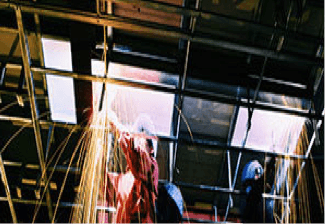American manufacturing might be hitting a ‘supercycle’ as spending skyrockets (Courtesy of the Jacksonville Business Journal) — Reston, Virginia-based defense and technology firm Leidos Holdings Inc. is spending $31.7 million to build a new manufacturing hub for its security systems in North Charleston, South Carolina.
The 150,000-square-foot-facility is the third of its kind in the United States and built with the express goal of bringing the company’s manufacturing abilities back to the United States. It will produce items for the company’s infrastructure customers, including in aviation, shipping ports and border crossings, when it is completed in 2024.
The Leidos project is among hundreds of manufacturing projects popping up across the country, partially the result of a series of massive spending bills passed under the Biden administration that has created the potential for what some experts are calling a manufacturing “supercycle” and manufacturing resurgence.
Manufacturing construction spending across the United States continues to smash through 20-year highs, hitting a $194 billion annual rate in April, nearly double the $107 billion annual rate from a year ago, according to the St. Louis branch of the Federal Reserve. Spending has continued to rise as legislation such as the CHIPS Act, the Inflation Reduction Act and the sweeping infrastructure legislation passed within the last few years continue to pump money and tax credits into manufacturing and related projects.
“Investors are about to be schooled on of one of the most enduring but unappreciated facts of economic life: that no country in the world — including China — attracts as much foreign direct investment as the U.S,” said Joseph Quinlan, head of Chief Investment Office Market Strategy for Bank of America Corp., in an analysis. “We highlight this unknown known because, yet again, the world’s top corporations are beating a path to the U.S.”
He stressed a number of fundamentals that are helping drive the return of manufacturing spending to the United States, including U.S. personal consumption spending, with Americans accounting for 30% of global consumption, despite making up only 4.5% of the population. America is also a relatively easy place to do business with a large, skilled labor pool, transparent rule of law and cheap energy costs, as well as low corporate tax rates, Quinlan said.
That’s on top of what Quinlan called “mega-legislation” that’s unlocked hundreds of billions in extra spending.
“America’s manufacturing base is on the cusp of a transformational do-over, and foreign firms want to be part of the action,” Quinlan said. “This requires that firms be ‘inside’ or ‘in-country’ to qualify for massive government incentives from both the federal and state levels.”
Companies are scrambling to rethink and rebuild their global supply chains after the pandemic, and the U.S. has become the destination for foreign corporate investment, with the country drawing in 23% of total foreign direct investment, up from 15% one year ago. China’s share was a distant second, Quinlan added.
“We believe the U.S. is in the early stages of a manufacturing supercycle pivoting around renewable energy, electrical vehicles and batteries/charging stations, and semiconductors, in addition to rising spending in more traditional areas like ports, highways, grids, airports and the like,” Quinlan said.
He dismissed concerns about a potential “manufacturing recession” because industrial and other stocks have underperformed the broader stock market recently, saying the industry should take the long view as it takes years to spin up manufacturing.
Some notable recent projects indicative of the rise in American manufacturing — you can see a map here — include:
- A June 1 announcement that European energy firms TotalEnergies SE and Tree Energy Solutions GmbH plan to build a $2 billion plant in Texas to manufacture natural gas.
- A $5 billion commitment by Wolfspeed Inc. to build a new semiconductor plant on a 400-acre site in Chatham County, North Carolina, the largest single project in North Carolina history. The state is putting up $1 billion in various incentives.
- A $1.2 billion battery cell gigafactory by American Battery Factory in Tucson, Arizona, announced in December.
But it’s not just high-profile industries getting in on the act. Origin USA, a textiles company, announced recently it was launching a line of performance sports apparel that will be made entirely within the United States instead of being shipped from overseas.
Pete Roberts, founder and CEO of Origin USA, told The Playbook that while large government subsidies are behind the book in manufacturing construction of heavy electronics, the focus on those “hot topics” neglects products that used to be at the heart of American manufacturing, such as apparel and footwear.
“It’s time for us to scale and meet the growing demand for quality, Made-in-the-USA apparel and footwear,” Roberts said. “To do this, we need more than just a dip into our already steep government deficit spending. We need people to believe in the hard work and the mission ahead of us. We need workers, bankers, teachers, investors, entrepreneurs and our government officials — in representation of the people they serve — to pour support into our domestic supply chains, address single points of failure and rebuild the communities and workforce that was abandoned decades ago.”
He said focusing on apparel and similar manufacturing sectors can help with carbon emissions, too, as it cuts the environmental costs of shipping textiles from overseas, as well as help eliminate ethical issues of clothing made overseas that often includes inhumane practices and forced labor.
Widespread support for domestic manufacturing
And there is broad, bipartisan support for American government support of U.S. manufacturing, with 70% of Americans wanting the government to do more to bring back manufacturing to the United States, according to polling conducted by Morning Consult for the Alliance for American Manufacturing.
About 82% think the federal government should offer incentives to relocate their factories to the United States and 78% said the federal government should be required to buy American with its own purchases.
“American voters have made it clear that the federal government must do more to bring valuable manufacturing jobs back to the United States,” said Scott Paul, president of the Alliance for American Manufacturing, in a press release. “There is a real opening for Congress and the Biden administration to continuously emphasize the progress that has been made and follow through on additional manufacturing, trade and Buy America policies.”
Overall, cities and states across the country have been working to seize on the manufacturing moment after a long period of decline in some portions of the country. An analysis by the McKinsey Global Institute says restoring manufacturing growth could boost America’s GDP by 15% over the current decade, potentially creating 1.5 million new jobs.
And while the Biden administration has focused on the number of manufacturing jobs created — about 800,000 over the past couple of years — experts see an industry in which automation, high-end technology and specialization will likely produce fewer jobs overall, but those positions will be higher paid.
That’s part of a long-term trend, with the share of manufacturing jobs as a percentage of the overall economy shrinking from a peak of roughly 39% in the 1940s — the height of World War II — to roughly 8.4% in January 2023.
Overall, manufacturing’s share of nominal gross domestic product has fallen from around 27% in the early 1950s to about 11%.

